What is the role of HR at a startup?
Have you ever worked in an office that had a helpful and friendly human resources (HR) department? Have you ever thought to yourself, I wish we had more HR support! or perhaps even Why do we even have HR? Human resources management is an essential part of running any organization, whether you are the owner of a small company or the CEO of an international corporation. Here are five examples of human resources in action.
1) Recruiting
Recruiting is one of your human resources jobs as an employer. Recruiters seek out and locate potential job candidates, before promoting them to hiring managers. The goal of recruiting is to discover candidates that you wouldn’t have otherwise found and fill positions for which you might not otherwise have found someone. This process can be extensive, costly, and time-consuming, but it’s worth it in terms of a higher return on investment (ROI).
2) Training
The first human resource example is training. Training is one of those things that everyone thinks they need, but not all businesses provide. A company's most valuable assets—its employees—can't work if they don't know how to do their jobs properly. And without proper training, companies can also face costly mistakes due to misunderstandings or lack of communication between departments and/or individuals. So make sure your business has an effective training program in place; your staff will appreciate it, and you'll be glad you did it in case an employee ever has a question about anything.
 |
| What is the role of HR at a startup? |
3) Employee Retention
Employee retention is a metric that shows how long employees stay with your company. It’s one of many metrics you can use to evaluate how effectively you’re recruiting and retaining new employees, as well as what kind of culture and environment you’re creating for your current staff. To measure employee retention, find out how many employees who were employed during a specific period still work at your company one year later. The percentage you arrive at will give you an idea of how successfully your business keeps workers around. If it's low, look for ways to improve employee morale and introduce programs that help them feel appreciated by their company; also consider upping compensation where possible so workers have more incentive to stay put.
4) Employee Succession Planning
You’re a small business owner and your right-hand employee just told you he's got to take his wife on an emergency vacation to visit her sick father in Singapore. What do you do now? In many businesses, that question is answered by panic and scrambling. But as a smart small business leader, you've already built up your staff with extra skills and backup employees who can pick up those duties when you need them. What's more, they're already trained in your company standards and work processes so they'll be able to step right in without much disruption - while allowing you time to figure out how to fill that open position again once your employee returns from leave.
5) Benefits
Payroll, recruiting and hiring, training, grievance resolution, and some legal aspects of labor. It’s a department that companies set up to manage all aspects of employee involvement. There are five basic types of human resource jobs: The payroll manager is responsible for ensuring that wages and other forms of compensation can be paid in a timely manner to all employees when they’re due. A finance person may handle payroll but only if it is a small firm or nonprofit with no dedicated HR department; she would also report to accounting on larger firms. A pay data analyst looks at how much different employees make for similar jobs across various business units in order to try to determine if salary inequities exist—and what should be done about them.
if you want to know about 5 Amazing ways to make money online
